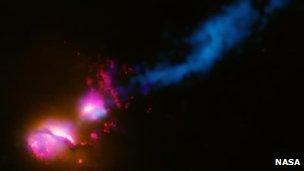Gas guzzler
- Published
- comments
Guy Fawkes' night may still be fresh in the memory, but astronomers are already jostling for ringside seats at an even more spectacular fireworks display.
Over the next few months the supermassive black hole at the centre of our galaxy will set about consuming a vast cloud of interstellar dust and gas - somewhat prosaically known as G2 - that has strayed too close to the singularity's event horizon.
It promises to be quite a show as all the material that doesn't get sucked into oblivion will be swept up, swirled around in a gigantic catherine wheel, heated, stretched, shredded and finally fired out again in a dazzling display of gravitational power. Not something astronomers get to see every day according to Dr Karen Masters from the Institute of Cosmology and Gravitation at Portsmouth University.
"The black hole at the centre of our galaxy is normally quite quiet, docile even, but as this cloud begins to fall in the material is going to get very, very hot and it's going to start emitting all sorts of radiation. We don't know exactly what's going to happen but we know it's going to be spectacular."
The galactic pyrotechnic display Sagittarius A* (as the black hole at the centre of the Milky Way is known) is about to unleash couldn't have come at a more opportune moment. NASA's latest space based X-ray telescope, NuSTAR, was only launched in June but is already offering a grandstand view of G2's death throes.
"We got lucky" says the mission's principal investigator, the California Institute of Technology's Fiona Harrison, "and caught an initial outburst from the black hole during our first observing campaign in July. But that's just a taste of what's to come next year, and NuSTAR will be there to catch it".
The excitement among astronomers has been fuelled by a growing appreciation for the role black holes seem play in limiting the size, and influencing the structure, of the galaxies that surround them.
Until recently Caleb Scharf, the director of Columbia University's Centre for Astrobiology, says black holes were dismissed as little more than - admittedly spectacular - cosmic plugholes.
"Black holes have had a bad rap. We've always thought of them as these dark, brooding destructive entities, but it turns out their influence is much more creative. Black holes help to regulate galaxies, acting a bit like a pressure valve that prevents star formation from running away with itself".

A powerful jet from a supermassive black hole blasts a nearby galaxy
In Gravity's Engines: The Other Side of Black Holes, Caleb Scharf takes this new appreciation for black holes to its logical conclusion, arguing that by dictating the large-scale structure of galaxies like the Milky Way, black holes have helped to establish the conditions necessary for life to emerge.
But it's the other, less creative, side of a black hole's personality that will be grabbing the headlines over the next few months.
"It's very exciting" Dr Scharf says "because it's the first time we've been able to predict something like this, and the first time we've had the telescopes and instruments ready to watch it in detail. We hope we'll see some of the processes at play in converting matter into energy around black holes".
The close encounter between Sagittarius A* and the G2 dust cloud is set to start early in the New Year. The latest simulations from the Lawrence Livermore National Laboratory in California suggest the massive cloud of dust and gas will have been completely consumed in less than a decade.
Quite a meal, even for a supermassive black hole.